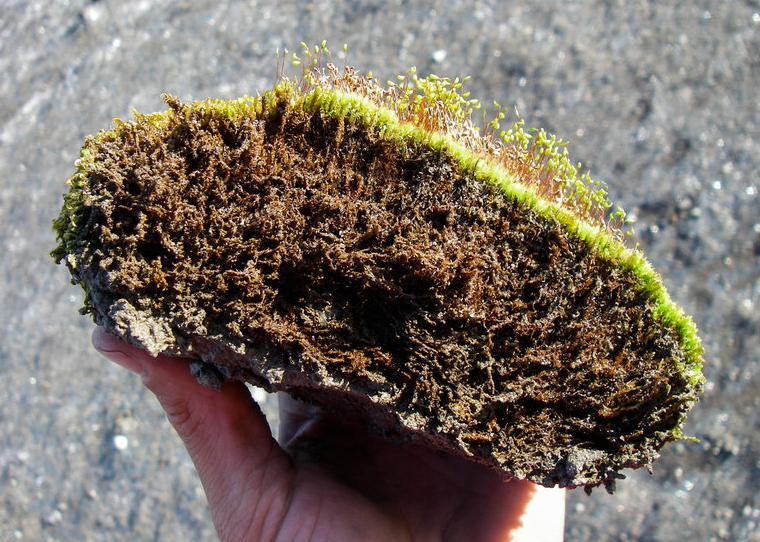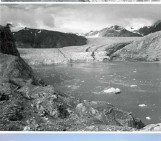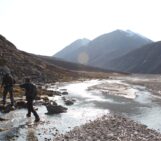
Glacier moss balls, also known as “glacier mice”, on the Root Glacier in south-central Alaska, USA. The moss balls develop on the glacier and move synchronously with one another throughout the same melt season. [Credit: Timothy Bartholomaus].
Did you know that glacier mice can be found at the surface of some glaciers? They’re not the tiny rodent you might be imagining, but actually little balls of moss, which appear to be full of mysteries still to be uncovered…
What is a “glacier mouse”?
On glaciers around the world, mostly at high-latitudes in the northern hemisphere, little balls of moss develop and move around the ice. Originally described as “jökla-mys” or “glacier mice” in the 1950s, as you can see from the photo, glacier moss balls really do resemble the scurrying vertebrate of their common namesake. Beyond similarities in appearance, the name glacier mouse no doubt also stems from their herd-like clustering and movements. Glacier moss balls are commonly found in curiously well-spaced congregations on glaciers. But, perhaps more interesting than their spaced clusters is their movement, which is surprisingly fast and synchronous. Indeed, during the height of summer, individual balls move 2-3 cm per day in the same direction! But what is their direction of movement? Well, we expected it to coincide with either the direction of the prevailing winds, the downslope direction of the glacier, or even the dominant direction of solar radiation. Yet, none of these hypotheses can fully answer that question. And, perhaps even more intriguing, how come that, whatever the direction, they always move as a group?!
So how do they move?
Unlike actual mice, glacier mice, as far as we know, move in stops and starts. Their mass insulates the ice directly below them which prevents it from melting while the surrounding ice recedes. Eventually they wind up perched on top of their own pedestal which, when it finally fails, causes them to roll. Once they have stopped moving, the process begins again. While the moss balls do tend to have one side that is flatter and less vegetated than the other (as you can see on the picture below), it is not uncommon to find them “upside down”. Thus, their movement pattern likely contributes to their overall rounded profile. So, while the mechanism of their movement is known – and our study has added two new pieces to broader understanding of their movement patterns: they move relatively quickly and in truly herd-like fashion! – a puzzling question remains: if it is not wind, slope, or sun, what is driving the direction of glacier moss ball movements on the Root Glacier? Is it a more complex interaction of factors that we’ve already considered or something else entirely? This is still to be discovered…

A cross-section of a glacier mouse on the Root Glacier, Alaska, USA. [Credit: Timothy Bartholomaus].
Moss balls and biodiversity
Contrary to popular belief, glaciers are not ecological dead zones. In fact, they are far from it. From microbes to vertebrates, a diverse swath of organisms live on, within, and downstream of glaciers (see, for example, Hotaling et al. 2020, Muhlfeld et al. 2020, or Stibal et al. 2020). Glacier moss balls represent yet another piece of this global puzzle. However, from a biodiversity standpoint, glacier moss balls take things a step further as they not only represent a portion of glacier biodiversity in their own right, but their presence creates space for other organisms, too. A number of invertebrates – including springtails, tardigrades, and nematode worms – have all been found within glacier moss balls. With (relatively) fast, coordinated movement that is difficult to explain and a host of invertebrate residents, what other moss ball mysteries remain?
Further reading
- Coulson, S. J., & Midgley, N. G. (2012). The role of glacier mice in the invertebrate colonisation of glacial surfaces: the moss balls of the Falljökull, Iceland. Polar Biology, 35, 1651-1658.
- Hotaling, S., Bartholomaus, T. C., & Gilbert, S. L. (2020). Rolling stones gather moss: Movement and longevity of moss balls on an Alaskan glacier. Polar Biology, 43, 735-744.
- Hotaling, S., Wimberger, P. H., Kelley, J. L., & Watts, H. E. (2020). Macroinvertebrates on glaciers: a key resource for terrestrial food webs?. Ecology, 101(4), e02947.
- Muhlfeld, C. C., Cline, T. J., Giersch, J. J., Peitzsch, E., Florentine, C., Jacobsen, D., & Hotaling, S. (2020). Specialized meltwater biodiversity persists despite widespread deglaciation. Proceedings of the National Academy of Sciences, 117(22), 12208-12214.
- Stibal, M., Bradley, J. A., Edwards, A., Hotaling, S., Zawierucha, K., Rosvold, J., … & Šabacká, M. (2020). Glacial ecosystems are essential to understanding biodiversity responses to glacier retreat. Nature Ecology & Evolution, 4(5), 686-687.
Edited by Violaine Coulon
 Scott Hotaling is a postdoctoral research associate at Washington State University, Washington, USA where he studies the ecology and evolution of glacier biodiversity (and other organisms living in cold places!). He tweets as @MtnScience. Email: Scott.Hotaling@wsu.edu.
Scott Hotaling is a postdoctoral research associate at Washington State University, Washington, USA where he studies the ecology and evolution of glacier biodiversity (and other organisms living in cold places!). He tweets as @MtnScience. Email: Scott.Hotaling@wsu.edu.



